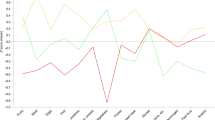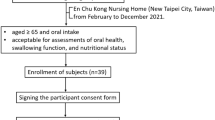Abstract
Objective: This paper describes the development of a reliable scale of standards for use in evaluating the progress of the transition from milk to solid food in infants and preschool children. The maturation of chewing and swallowing behavior in infants and young children, which enables processing of solid food, varies, and a scale would assist not only in the instruction of mothers and nurses but also in preventing delay in the introduction of solid food.
Design: A range of 159 reference foods were selected on the basis of intake during the period of transition from liquid to solid food. These foods were listed in our previous study, Validity and reliability were tested to create a scale.
Methodology: Foods were selected on the basis of 50% of the subjects studied being able to eat them, and on the food groups classified by cluster analyses using the Varclus procedure of SAS. Validity, of the scale was tested by using Pearson's correlation coefficient between the scale score of selected food items and the total score of all 159 food items. The total score of 159 food items was calculated using the general linear models (GLM) procedure of SAS. Reliability was tested using Cronbach's coefficient α.
Setting: Public health centers in Aomori, Tokyo, Saitama, Nagano, and Okinawa (Japan).
Subjects: Five hundred and eighty healthy mothers and children from 2 to 46 months were randomly selected and 470 (81.0%) completed the study. To avoid regional bias, subjects were drawn from northern to southern prefectures in Japan, namely Aomori, Tokyo, Saitama, Nagano, and Okinawa.
Results: Twenty food items were selected. By analyzing the score correlation using Pearson's correlation coefficient (R=0.97, P<0.001) and GLM (R2=0.95, P<0.001), it was confirmed that these 20 food items adequately represented the original 159. The reliability was also found to be sufficient (Cronbach's coefficient α=0.96).
Conclusions: The findings demonstrate that a scale of standards for measuring progress in chewing ability can be created using 20 food items. Such a standard will provide a useful basis against which to assess delay of solid food introduction in childhood.
Sponsorship: Grant-in-Aid for Scientific Research, provided by the Japanese Ministry of Education, Science and Culture, Project No. 07838030.
This is a preview of subscription content, access via your institution
Access options
Subscribe to this journal
Receive 12 print issues and online access
$259.00 per year
only $21.58 per issue
Buy this article
- Purchase on Springer Link
- Instant access to full article PDF
Prices may be subject to local taxes which are calculated during checkout
Similar content being viewed by others
References
American Department of Health (1986): How to Feed Your Baby. The First Year. Bethesda American Department of Health.
Ammine EK, al-Awadi F & Rabrie M (1989): Infant feeding pattern and weaning practices in Kuwait. J.R. Soc. Health 109, 178–180.
Asikawa H (1999): Cooperative movement of masticatory muscles as seen in the development of mastication in infants. J. Pediatr. Dent. 37, 933–947.
Australian Women's Weekly (1999): Babies and Toddlers Good Food. Sydney: The Australian Women's Weekly Home Library.
Croner S, Kjellman NIM & Erikson B (1982): IgE screening in 1701 newborn infants and the development of atopic disease during infancy. Arch. Dis. Chiild. 57, 364–368.
Department of Health Sciences, Stargent Collage of Allied Health, Boston University (1992): Weaning recommendation: the scientific basis. Nutr Rev. 50, 125–133.
Ezawa I (1994): Jaw development in childhood. Pediatr. J. 40, 359–366.
Gisel EG (1991): Effect of food texture on the development of chewing of children between six months and two years of age. Dev. Med. Child. Neurol. 33, 69–79.
Guilford JP (1954): Psychometric Theory, 2nd Edition, pp. 380–385. New York: McGraw-Hill.
Guldan GS, Zang MY, Zang YP, Hong JR, Zhang HX, Fu SY & Fu NS (1993): Weaning practices and growth in rural Scichan infants: a positive deviance study. J. Trop. Pediatr. 39, 168–175.
Hartmann WM & Sarle WS (1988): Varcluster. In SAS Statistical Text, pp. 995–1014. North Carolina: SAS Institution.
Imamura E (1980): Basical Instruction of Weaning (in Japanese). Tokyo: Isiyaku Publishing Co.
Imamura E (1983): Child nutrition with regards to the development of the masticatory system (in Japanese). J. Pediatr. Pract. 36, 31–35.
Inoue M (1983): Health education for the infant aged 3 years (in Japanese). Sikaitenbo. 62, 1235–1240.
Inoue N, Kuo CH, Ito G, Shiono K, Kamegai T, Seino Y, Yuyama Y, Takagi O & Taura K (1983): Influence of tooth-to-denture base discrepancy on space closure following premature loss of deciduous teeth. Am. J. Orthod. 83, 428–434.
Inoue N (1993): Collapse of dentition in Japan. In Culture of Food and Oral Health in Maori, ed. N Inoue, pp. 99–104. Tokyo: Therapia Publishing Co.
Inoue N, Sakashita R & Kamegai T (1995): Reduction of masseter muscle activity in bottle-fed babies. Early Hum. Dev. 42, 185–193.
Inoue N, Sakashita R & Kamegai T (1998): The effect of chewing type nipple on the growth of the jaw bone: evidence from the study of size of arch length discrepancy. Orthod. Waves 57, 403–408.
Ito G, Kuroe K, Inoue N & Kamegai T (1982): Experimental approach to jaw reduction. J. Dent. Res. 61, 596.
James WP, Nelson M, Ralph A & Leather S (1997): Socioeconomic determinants of health. The contribution of nutrition to inequalities in health. Br. J. Med. 314, 1545–1549.
Kannel A (2001): Annabel Karmel's New Complete Baby and Toddler Meal Planner. London, Ebury Press.
Liu ZJ, Ikeda K, Harada S, Kasahara Y & Ito G (1998): Functional properties of jaw and tongue muscles in rats fed a liquid diet after being weaned. J. Dent. Res. 77, 366–376.
Marchioni DM, Latorre Mdo R, Szarfarc SC & de Souza SB (2001): Complementary feeding: study on prevalence of food intake in two health centers of Sao Paulo city. Arch. Lotinoam. Nutr. 51, 161–166.
Maternal and child health (MCH) division of child and family bureau (1986) Report on the Survey of Infant Nutrition (in Japanese): pp.1–102. Tokyo: The Ministry of Health and Welfare Japan.
Nakano H (1993): Functional development of masticatory system. In Culture of Food and Oral Health in Maori, ed. N Inoue, pp. 99–104 Tokyo: Therapia Publishing Co.
Nystrom M, Peck L, Kleemola-Kujala E, Evalahti M & Kataja M (2000): Age estimation in small children: reference values based on counts of deciduous teeth in Finns. Forensic. Sci 110, 179–188.
Pereira MA, Ludwig DS (2001): Dietary fiber and body-weight regulation. Observations and mechanisms. Pediatr. Clin. North Am. 48, 969–980.
Rolland-Cachera MF, Deheeger M & Bellisle F (1997): Nutrient balance and body composition. Reprod. Nutr. Dev. 37, 727–734.
Sakashita R (1992): Diet—its influence on oral health (3): Japanese infants (in Japanese). Dent. Hyg. Jpn. 12, 933–942.
Sakashita R (1996): Food and oral health. In Culture and dental health in Kenya, eds. N Inoue, T Kamegai R Sakashita, pp. 167–178. Tokyo, Terapaia Publishing Co.
Sakashita R, Inoue N, Kamegai T (1996): Masseter muscle activity in bottle feeding with chewing type bottle teat. Early Hum. Dev. 15, 83–92.
Sakashita R, Inoue N, Pan Q & Zhu H (1997): Diet and diserepancy between tooth and jaw size in the Yin-Shang period of China. Am. J. Phys. Anthropol. 103, 497–505.
Sakashita R, Inoue N, Watanabe K, Watanabe M & Kamegai T (1998): Electromyographic evidences for sufficient and insufficient developmental space in juvenile jaws. Orthod. Waves 57, 409–416.
Sakashita R, Inoue N & Tastuki T (2001): Studies on transitional process from milk to solid food in infants. Kumamoto J. Maternal Health 5, 24–32.
Serenuis F, Swailem AR, Edressee AW & Hofyander Y (1988): Patterns of breast feeding and weaning in Saudi Arabia. Acta. Paediatr. Scand. Supple. 346, 121–129.
Shirakawa M, Okamoto J, Morio Y, Miura I, Nagasaka N (1985): A study on the development of mastication in infants (in Japanese). Jpn. J. Pediatr. Dent. 23, 666–677.
Society for Maternal and Child Health (1997): Basical Instruction of Weaning (in Japanese). Tokyo: Maternal and Child Health Society.
Tamura F, Chigira A, Ishii H, Nishikata H & Mukai Y (2000): Assessment of the development of hand and mouth coordination when taking food into the oral cavity. Int. J. Orofacial. Myol. 26, 33–43.
Warrington S & Storey DM (1988): Comparative studies on Asian and Caucasian children. 2: Nutrition, feeding and health. Eur. J. Clin. Nutr. 42, 69–79.
Westenhoefer J (2001): Establishing good dietary habits—capturing the minds of children. Public Health Nutr 4, 125–129.
Wood CBS (1986): How common is food allergy? Act. Paediatr. Scand. Suppl. 323, 76–83.
Yokoi S (1998): Weaning food: the oral function (in Japanese). Tokyo. Pediatr. J. 17, 16–20.
Yokomizo M (1992): Research on development of masticatory behavior in kindergartners (in Japanese). J. Dent. Health 42, 227–306.
Yurkstas A & Manly RS (1950): Value of different foods in estimating masticatory ability. J. Appl. Physiol. 3, 45–53.
Acknowledgements
The authors express their sincere appreciation for the co-operation of mothers and children. They are also indebted to the directors, Public Health nurses and staff at Public Health Centers in each district for their kind cooperation and support. They are grateful to Theya Molleson (The Natural History Museum, UK) for comments on an earlier version of this paper and Veronica Hunt (The Natural History Museum, UK) for the refinement of English.
Author information
Authors and Affiliations
Contributions
Guarantor: R Sakashita.
Contributors: RS participated in the study design, collected the data, did the statistical analysis, participated in the discussion of results and wrote the paper. NI participated in the study design, coordinated the study participated in the discussion of results and reviewed the paper. TT coordinated the study, and participated in the discussion of results.
Corresponding author
Rights and permissions
About this article
Cite this article
Sakashita, R., Inoue, N. & Tatsuki, T. Selection of reference foods for a scale of standards for use in assessing the transitional process from milk to solid food in infants and pre-school children. Eur J Clin Nutr 57, 803–809 (2003). https://doi.org/10.1038/sj.ejcn.1601612
Received:
Published:
Issue Date:
DOI: https://doi.org/10.1038/sj.ejcn.1601612
Keywords
This article is cited by
-
Evaluation of Aflatoxins Occurrence and Exposure in Cereal-Based Baby Foods: An Update Review
Current Nutrition Reports (2024)
-
From milk to solids: a reference standard for the transitional eating process in infants and preschool children in Japan
European Journal of Clinical Nutrition (2004)



